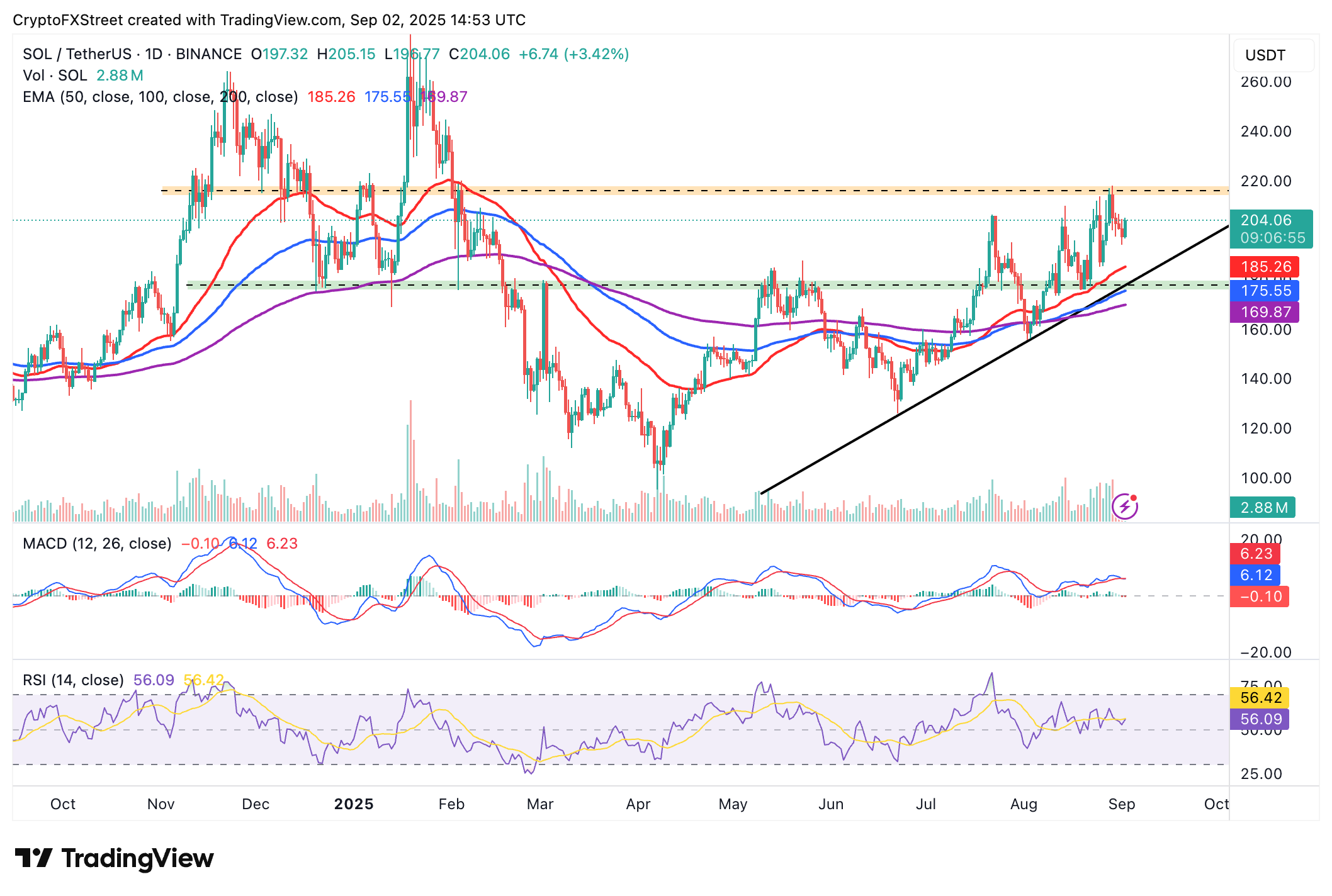Solana eyes record highs on Alpenglow upgrade, ETF potential and whale accumulation
- Solana hovers around $200 as profit-taking quickly snuffs intraday gains in the broader crypto market.
- Solana's Q4 bullish case hinges on the Alpenglow upgrade, potential ETF approvals and whale accumulation.
- Whale accumulation raises concerns of potential dumping activity that could erase gains.
Solana (SOL) holds above $200 on Tuesday as digital assets in the broader cryptocurrency market struggle to retain intraday gains. The Proof of Stake (PoS) token is pointing toward a bullish scenario in the fourth quarter, underpinned by a key network upgrade proposal, the potential approval of Exchange Traded Funds (ETFs), and whale accumulation during dips.
The short-term price forecast indicates a surge above $220, with the medium-term target in the range of $250 to $300, and a long-term projection of up to $500 per SOL token by the end of 2025.
Assessing Solana's bullish case
Solana's protocol upgrade has gained tremendous support from network validators. According to CoinMarketCap (CMC), the Alpenglow proposal has garnered 99.6% favorable votes two days before the governance process concludes.
The proposal initiated by the Anza development firm in May would make a significant protocol upgrade, with transaction finality dropping to approximately 150 milliseconds after its implementation.
If implemented, the Alpenglow upgrade would bring Solana's response times in line with those of Google search. In comparison, Ethereum (ETH) requires 12 to 13 seconds for inclusion and up to 12 minutes for transaction finality.
The Alpenglow upgrade is poised to unlock new applications for Solana that require real-time performance. Moreover, competitive performance with web2 platforms, such as Google Search, could expand the protocol's application to new horizons.
Solana ETFs have a 95% approval chance
Various fund managers have filed with the United States (US) Securities and Exchange Commission (SEC) seeking approval to launch Solana ETFs. The SEC is considering proposals from 21Shares, Bitwise, Canary Capital, CoinShares, Fidelity, Grayscale, Invesco Galaxy and VanEck, with Bloomberg analysts' approval odds of 95%.
Beyond the ETFs, institutional investors have been increasing exposure, taking advantage of price dips. According to CMC, "whale activity shows $381 million accumulation during August dips but $17 million sell-offs still trigger 5% price swings."
Key catalysts for Solana's next move hinge on the network upgrade, which would open the protocol to new users and potentially lead to ETF approvals. ETF approvals have been a major catalyst for the rallies seen with Bitcoin (BTC) and Ethereum, with Solana poised to benefit from institutional capital inflows.
Technical outlook: Solana eyes short-term breakout
Solana is positioned above the $200 level after four consecutive days of declines. The token also sits above key moving averages, including the uptrending 50-day Exponential Moving Average (EMA) at $185, the 100-day EMA at $175 and the 200-day EMA at $169.
Sentiment around SOL remains relatively bullish, backed by growing institutional demand, retail interest and network growth ahead of the Alpenglow upgrade.
Traders will look out for a buy signal from the Moving Average Convergence Divergence (MACD) indicator, which would encourage them to increase exposure ahead of the short-term breakout toward the $220 hurdle.

SOL/USDT daily chart
Solana holding above the $200 psychological level is crucial for sustaining a steady uptrend in the short term. Still, a correction below the same level cannot be ruled out, especially with macroeconomic headwinds overhanging. If a trend correction occurs, the 50-day EMA at $185, the 100-day EMA at $175 and the 200-day EMA at $169 would be in line to absorb the selling pressure.
Cryptocurrency prices FAQs
Token launches influence demand and adoption among market participants. Listings on crypto exchanges deepen the liquidity for an asset and add new participants to an asset’s network. This is typically bullish for a digital asset.
A hack is an event in which an attacker captures a large volume of the asset from a DeFi bridge or hot wallet of an exchange or any other crypto platform via exploits, bugs or other methods. The exploiter then transfers these tokens out of the exchange platforms to ultimately sell or swap the assets for other cryptocurrencies or stablecoins. Such events often involve an en masse panic triggering a sell-off in the affected assets.
Macroeconomic events like the US Federal Reserve’s decision on interest rates influence crypto assets mainly through the direct impact they have on the US Dollar. An increase in interest rate typically negatively influences Bitcoin and altcoin prices, and vice versa. If the US Dollar index declines, risk assets and associated leverage for trading gets cheaper, in turn driving crypto prices higher.
Halvings are typically considered bullish events as they slash the block reward in half for miners, constricting the supply of the asset. At consistent demand if the supply reduces, the asset’s price climbs.

